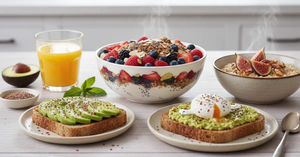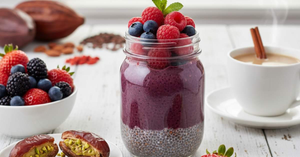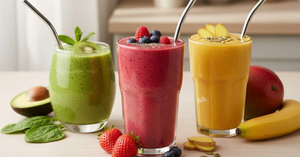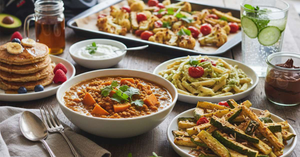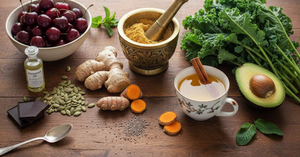“When your belly feels heavy, let your food be your gentle medicine.”
Bloating during menstruation is one of the most common and frustrating symptoms women face. It can start a few days before your period and peak around day one or two. The main culprits are hormonal fluctuations, particularly rising progesterone and estrogen levels, which cause fluid retention and affect digestion.
As progesterone slows down bowel movement, gas and constipation can make the abdomen feel swollen and tender. Additionally, salty foods, caffeine, and processed snacks can worsen water retention.
The good news is that with the right foods and light, anti-inflammatory, and rich in fiber and potassium, you can ease bloating naturally and feel much more comfortable.
Certain ingredients help your body release extra water, improve digestion, and reduce inflammation:
These nutrients can be easily included in everyday recipes without long cooking times.
Here are easy, home-friendly recipes that use ingredients commonly found in Indian kitchens and can be made in under 15 minutes.
Ingredients:
How to make:
Add ginger to warm water and let it steep for 3–4 minutes. Add lemon juice and sip slowly on an empty stomach.
Why it helps:
Ginger reduces inflammation, boosts digestion, and improves circulation. Lemon aids liver detoxification and helps relieve that heavy, water-retained feeling.
Ingredients:
How to make:
Blend all ingredients and serve chilled.
Why it helps:
Buttermilk supports gut-friendly bacteria, while cucumber and mint have natural diuretic and cooling properties that ease bloating and reduce puffiness.
Ingredients:
How to make:
Pressure to cook moong dal with vegetables, turmeric, and water. In a separate pan, heat ghee, add cumin seeds, and mix into the soup.
Why it helps:
Light, protein-rich, and easy to digest, moong dal helps flush out excess water and sodium. The turmeric-ghee combination soothes cramps and reduces inflammation.
Ingredients:
How to make:
Blend everything until smooth and creamy.
Why it helps:
Papaya contains papain, an enzyme that aids digestion and reduces bloating. Coconut water restores electrolyte balance, while flaxseeds provide gentle fiber to ease constipation.
Ingredients:
How to make:
Lightly steam the vegetables until soft. In a pan, heat oil, add cumin seeds, toss the vegetables, and finish with lemon juice.
Why it helps:
Cumin improves digestion and prevents gas formation. Steamed vegetables are light on the stomach but rich in fiber and minerals that ease water retention.
Ingredients:
How to make:
Mix chia seeds in warm milk and let it rest for 10 minutes. Top with sliced banana and cinnamon.
Why it helps:
Banana provides potassium, which balances sodium and reduces bloating. Chia seeds add fiber and omega-3 fats that calm inflammation.
Ingredients:
How to make:
Boil fennel and ginger for 5 minutes, strain, and sip slowly.
Why it helps:
Fennel relieves gas and bloating by relaxing intestinal muscles. It’s an excellent post-meal drink during your period.
Ingredients:
How to make:
Cook quinoa and dal together with turmeric and vegetables. Add ghee and lemon before serving.
Why it helps:
Quinoa is rich in fiber, magnesium, and protein which are perfect for keeping digestion smooth while preventing post-meal heaviness.
Ingredients:
How to make:
Boil the apple slices and cinnamon together for 10 minutes. Strain and drink warm.
Why it helps:
Cinnamon reduces sugar cravings and inflammation. Apples add soluble fiber (pectin), which supports digestion and gut health.
Apart from what you eat, how you eat also affects bloating. Follow these simple habits to support digestion naturally:
While cravings hit hard during PMS, some foods worsen bloating and discomfort:
Instead, stick to warm, home-cooked, lightly spiced meals that comfort your system and calm inflammation.
Occasional bloating during menstruation is normal, but if it becomes severe, painful, or persistent, it could indicate conditions like endometriosis, IBS, or hormonal imbalances. Consult your gynecologist or a nutritionist for evaluation and tailored dietary support.
Menstrual bloating can make you feel uncomfortable and drained, but small food choices can bring big relief. The best approach is to eat light, stay hydrated, and rely on foods that support your hormones naturally.
These quick recipes from ginger teas to warm khichdi and fruit smoothies are easy ways to comfort your body and ease discomfort without medications. Each time you choose wholesome, gentle foods, you remind your body that it’s safe, supported, and cared for even during your most sensitive days.
About PeriodSakhi
PeriodSakhi is your trusted companion for understanding your menstrual health. With easy-to-use tools, it helps you track your periods, ovulation, fertility, moods, and symptoms, while providing insights into your overall reproductive and hormonal health. PeriodSakhi also serves as a supportive online community where women can share experiences, find reliable information, and access expert-backed guidance on menstrual health, PCOS, pregnancy, lifestyle, and more.
Disclaimer
The views, thoughts, and opinions expressed in this article/blog are solely those of the author and do not necessarily reflect the views of PeriodSakhi. Any omissions, errors, or inaccuracies are the responsibility of the author. PeriodSakhi assumes no liability or responsibility for any content presented. Always consult a qualified medical professional for specific advice related to menstrual health, fertility, pregnancy, or related conditions.
Start the conversation
No comments yet. Start the conversation by leaving the first comment!
